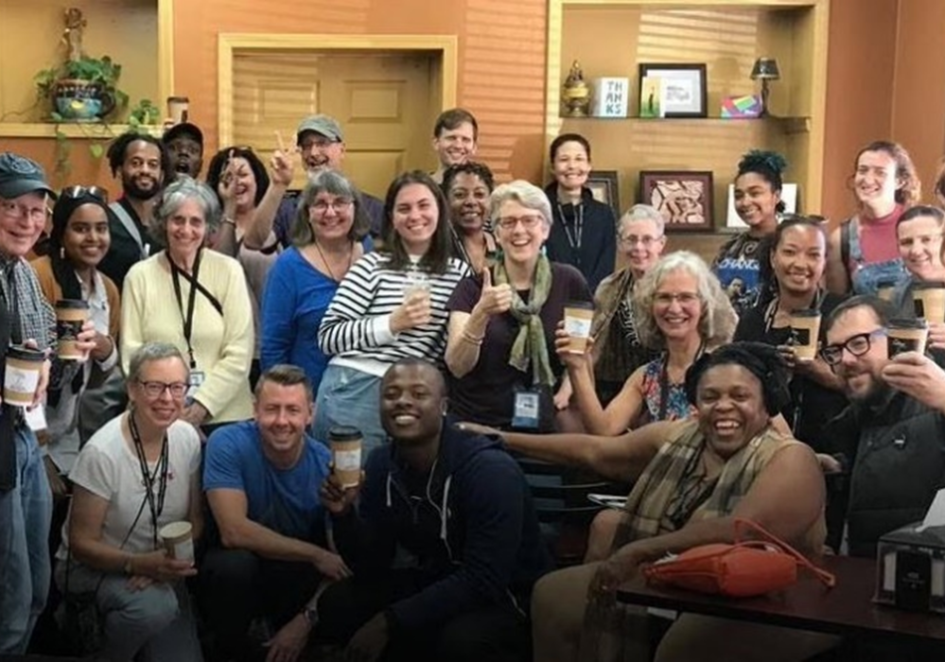December 20, 2019
Project Pilgrimage: Building Our Stamina for Racial Justice

Last night Laird Harris, former WithinReach Board member, and I had the opportunity to share reflections with present and past WithinReach Board leadership from our recent pilgrimage to the U.S. south.
Project Pilgrimage, a local not-for-profit, aims to build intergenerational, interracial community and leads pilgrimages to the south to study the civil rights movement, the arc of the African American freedom struggle and the systems of racial inequity that are alive and well in our country today. Laird and I, along with 27 other people, came together to take the pilgrimage. As I shared in my pre-pilgrimage blog post, I decided to participate in Project Pilgrimage as a way to recognize my 20th year at WithinReach, which our Board of Directors fully supported, as part of my leadership development and our organization’s path to diversity, equity and inclusion.
Laird and I both felt strongly that to fully embrace our commitment to racial justice and anti-racist action, we needed to immerse ourselves in the truth about the race-based oppression that is a fundamental part of our country’s history. As I have heard Bryan Stevenson, author of Just Mercy and CEO of the Equal Justice Initiative say, “you can’t get to reconciliation without going through the truth.”
Over eight days, we travelled by bus through Louisiana, Mississippi and Alabama on a pilgrimage that transformed us through truth, grief, sacrifice, reconciliation, music and hope. We saw and learned so many disturbing truths about slavery, lynching and the evolution of racial control in our country. We began to build greater muscle to be anti-racists, by listening deeply to stories of racial oppression. We breathed in the power and joy of our newfound interracial and intergenerational community, as a pathway to racial justice stamina and enduring hope.
Here are three key takeaways from the pilgrimage:
Speaking the Truth
Throughout our trip we were faced with overwhelming truths, but one of the most impactful for Laird and I came through the story of the death of Emmett Till. On the edge of dusk, we visited the Emmett Till Interpretive Center and Memorial. Emmett Till was 14 years old when he was accused of having inappropriate contact with a Mississippi grocery store owner’s wife. A few nights later, he was kidnapped, tortured and murdered – his mutilated body found in the Tallahatchie River.
His killers were acquitted, but later confessed to killing Emmett in a magazine article. Emmett’s Mom, Mamie, demanded an open casket funeral so the world would have to face the truth surrounding hisd death. The Memorial Marker on the river’s edge has been destroyed three times, with bullet holes, acid and other methods. A fourth sign – bulletproof and protected by online surveillance – was recently dedicated. The week after we returned to Seattle, a white supremacist group videotaped a promotional video in front of the sign. Although there is an urgent need to stand in and speak the truth of our country’s past, there remains a competing and forceful desire to keep the truth buried to maintain white supremacy through continued, real and intentional racial oppression.
As the sun set that day, we held a silent and tearful memorial at the site where Emmett’s body was found. Each of us offered a flower to the river in the name of other black men or boys who have died due to racial injustice – Trayvon Martin, Jemel Roberson, Michael Brown, Tamar Rice, Stephon Clark …
Slavery Has Not Ended, It Has Evolved
During our time in Louisiana, we took a deep look at the roots of slavery and racial control. New Orleans was one of the largest slave ports and, at its height, had more than 50 slave markets in a 74-block area. We also toured the Whitney Plantation – the only plantation in Louisiana that focuses solely on the experiences of the enslaved. The Whitney tells the stories from the perspectives of the women, men and children who were imprisoned in the forced labor system of this sugar and rice plantation, where slave owners used intimidation, torture and threats of death to keep slaves in place. In a frame of white nostalgia, plantation tourism often depicts a time and place of union and delight – despite the fact that they are undeniably connected to slavery.
Today, we have the school to prison pipeline, mass incarceration, forced prison labor and communities like New Orleans, where an $8 billion tourism business is built largely on the backs of black and brown people who work for less than livable wages (the current minimum wage in New Orleans in $7.25 an hour). It became overwhelmingly clear that slavery was never really over, it just evolved, and that racial oppression and control lives on today in systems that are still – knowingly or unknowingly – built to uphold a preference for whiteness.
Without a doubt, the history of racial oppression in this country has created unfathomable physical, psychological and social trauma in the lives of African Americans, and this trauma lives on today.
Finding Hope
It is hard to feel hopeful about the path to racial justice and reconciliation as one learns the hard and true history of lunch counter sit-ins; the death of civil rights activists, Chenay, Goodman and Schwerner; the bombing of 16th Street Baptist Church in Birmingham, which killed four young girls; Bloody Sunday; the murder of Medgar Evers; and the story of lynching.
Yet, our trip was filled with messages of hope and healing. We had the great fortune to travel through our pilgrimage with three “foot soldiers” – people who lived, led and sacrificed throughout the civil rights movement to help create a different world for all of us.
Carolyn McKinstry, Bernard Layfette and Bob Zellner travelled with us through the week, and were all very active in the civil rights struggle. Side by side with Martin Luther King, James Lawson, Ralph Abernathy, John Lewis and many others, they helped organize and participated in the lunch counter sit-ins, Freedom Rides, voting rights movement, Children’s March and many other actions. They witnessed incredible acts of violence as teenagers and young adults, and were attacked, beaten, brutalized with fire hoses and jailed many times. They sacrificed their mental and physical health many times over in the fight for racial justice and equity.
They impressed upon us that we needed to build our stamina for racial justice, because justice and reconciliation are realized in the long game. They described how they fortified themselves through music, humor, good food and by “welding” themselves to one another. They were accessible, knowledgeable and hopeful guides on our pilgrimage. And, they reminded us, as Martin Luther King often did, that hope and love will prevail.
I also found power and hope in the art of Brandon Michael Odums at Studio Be, in New Orleans. In his show, Ephemeral Eternal, Odums – also known as BMike – explores the intersection of art and resistance through large-scale paintings done mostly in spray paint. Illustrating the impact of brief and lasting moments in the struggle for justice, the images are filled with dignity, beauty, strength and hope.
As we made our way to Atlanta to fly home, I was reminded of Martin Luther King’s 1965 speech: Where do we go from here? He said: “And so, I conclude by saying today that we have a task, and let us go out with a divine dissatisfaction … Let us be dissatisfied until those who live on the outskirts of hope are brought into the metropolis of daily security.”
I could not agree more – divine dissatisfaction is the only response to the racial injustice in our country, past and present. At WithinReach, it is this dissatisfaction that motivates us to work toward health equity, so that every Washington family has the opportunity to be healthy and safe.




